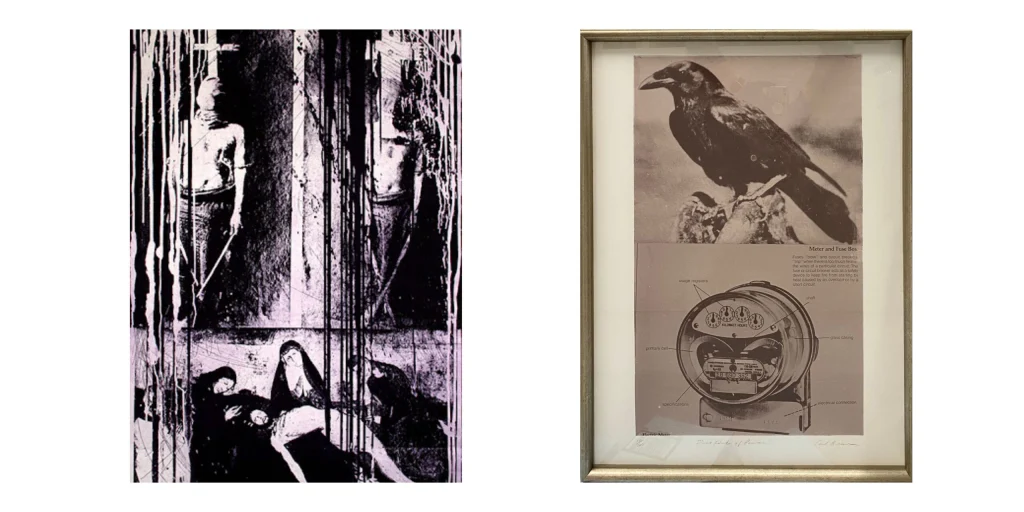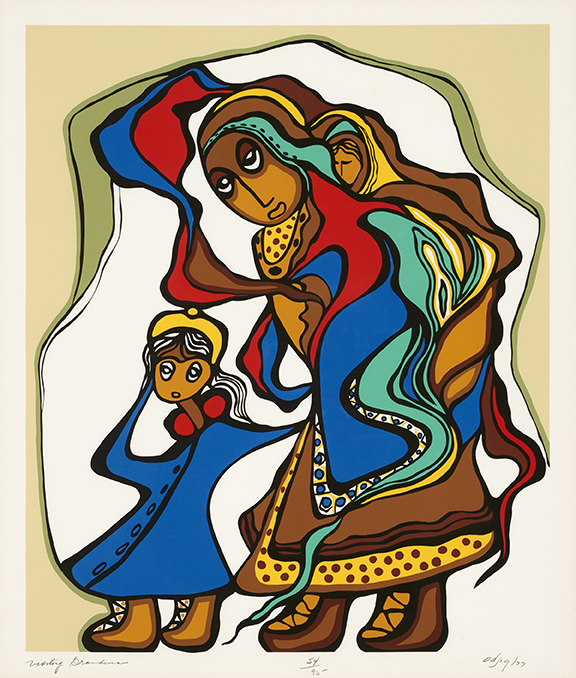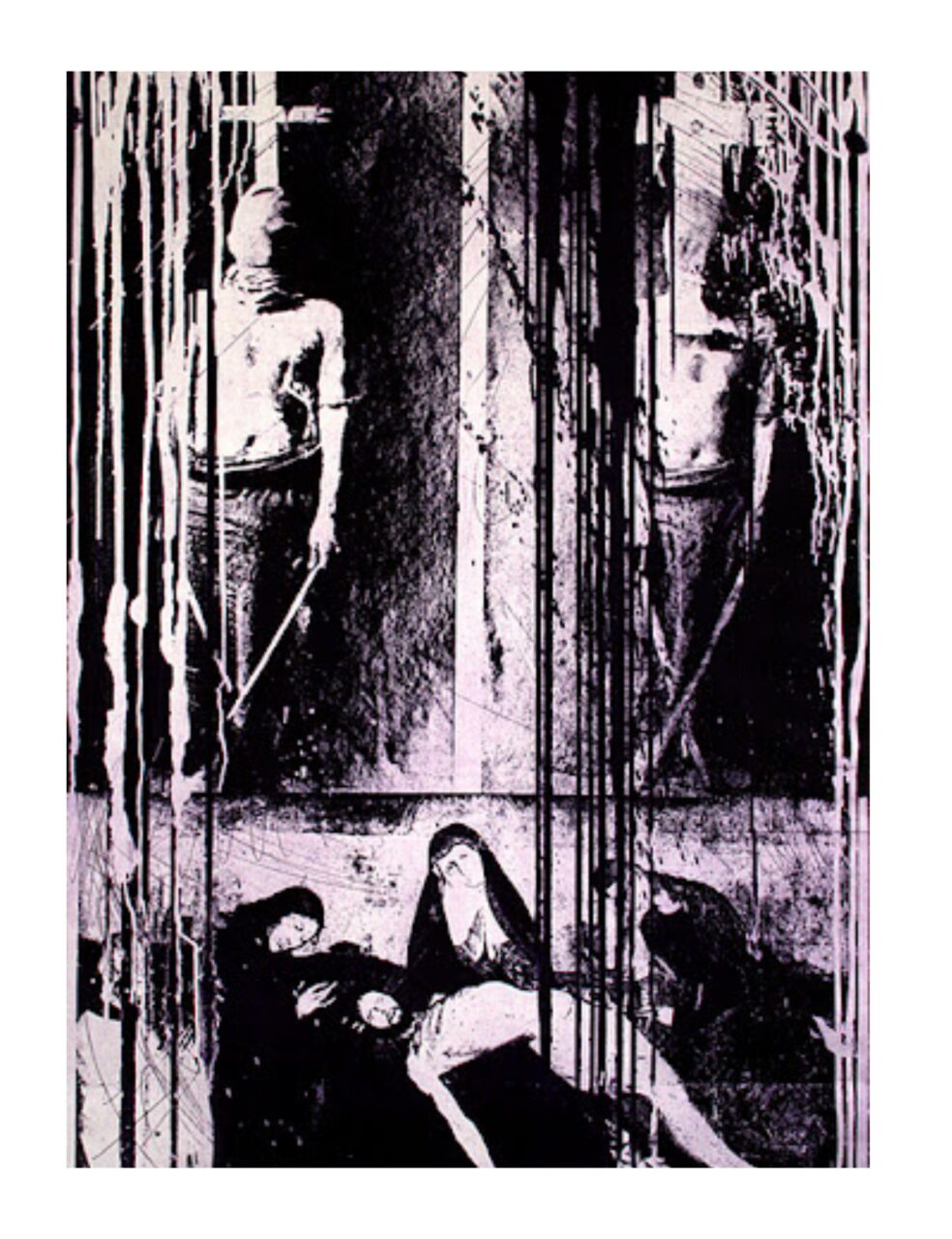Make More Art
December 6, 2021
Written by Caliesha Harris, Trent University Intern, 2021
Standing in the Art Gallery of Peterborough, I stare at a red rectangular canvas, with three words in black paint scrawled across the top. “Use Less Words” the canvas instructs. The painting, completed by Micah Lexier in 2007, is a powerful reminder that art can, and should, be allowed to speak for itself. For the past forty-seven years, the AGP has been dedicated to providing a space for Indigenous artwork to do just this.
The Art Gallery of Peterborough first opened its doors to the public on June 19, 1979. Situated on the banks of Little Lake, the gallery is located on Treaty 20 Michi Saagiig territory and in the traditional territory of the Michi Saagiig and Chippewa Nations, collectively known as the Williams Treaties First Nations. Since its conception, the Art Gallery of Peterborough has been dedicated to growing and showcasing the Indigenous portion of its collection.

Tamara Butler donated a significant amount of Indigenous art in 1987, including works by Odjig, Morrisseau, Wescoupe, and Bell. The works in this group, Butler writes, are concerned with unity. Unity between humans and animals, between Indigenous and non-Indigenous Canadians, and between the artist and the spectator are all common themes. In a letter dated 1988, Tamara Butler highlights the Bell’s “How the Fish Got Their Names” and Morrisseau’s “Tala, Sunshine and Light” as her favourites of the group. She was hesitant to part with them but recognizes that they would be important features of the AGP collection.
As a whole, the AGP’s Indigenous collection is diverse, including paintings, photographs, and sculptural works. Each work tells a unique story, engaging with the artist’s personal experiences or aesthetic values. Some artistic inspiration, in the case of Daphne Odjig and Norval Morrisseau, likely derived from early Midewewin legends, recorded in scrolls and passed down through oral tradition. In other cases, inspiration came in response to socio-political tensions. Carl Beam and Rebecca Belmore are great examples of artists whose art created a conversation around the contemporary response to historical issues.
Looking at the Past
Throughout her artistic career, Odjig sought to challenge traditional narratives about Indigenous history and colonialism. She frequently incorporated Anishinaabe legends and history into her art, illuminating the narratives she grew up learning about. Of her influence, Odjig maintains that she is “deeply pleased if it has helped to encourage the young people … to express their pride in our heritage more openly, more joyfully than I would have ever dared to think possible.”
Odjig’s style shifted throughout her lifetime. She received an artistic education from her grandfather Jonas, who himself worked as a stone-carver. Her style evolved throughout her lifetime, from ink and pen drawings to Impressionist landscapes, and of course the colourful narratives evocative of the Woodland style. The AGP has several of her pieces, including three that Odjig illustrated in 1968 for Dr. Herbert Schwarz’s Tales From the Smokehouse, and several other paintings. One of the most interesting is “Visiting Grandma”, completed in 1977 and acquired by the AGP in 1987 via a donation by Tamara Butler.
“Visiting Grandma” is a dynamic piece. A child and her grandmother are depicted, holding hands as they look into the distance. The colours are magnificent; bright red, blue, yellow, and turquoise grab the spectator’s attention. One of the most interesting elements of this piece, however, is the third face, tucked behind the grandmother’s ear. The features are less detailed than the other two figures, but it is undoubtedly still a face. From the title, we know that Odjig wanted to highlight the relationship between a child and her grandmother, but as the hidden face reminds us, the roots of this relationship go beyond these two individuals. Even in death, their ancestors live on in stories and memories passed down through oral tradition. When the child is visiting her grandmother, therefore, she is also coming into touch with her past–learning about their shared Anishinaabe culture just as Daphne learned from her grandfather. The painting is a reminder that we all have roots: we all wear the face of ancestors we will never meet and learn about the world around us from people who no longer inhabit it. It is a powerful statement, in the face of centuries of genocide and abuse from the Canadian government and Catholic Church, that Indigenous ways of life will not be silenced.

Odjig’s style is often compared to that of Norval Morrisseau, who pioneered the Woodland Style. The AGP acquired Morrisseau’s “Tala, Sunshine and Light” in 1987 as a donation from Tamara Butler. This work, along with the rest of Morrisseau’s paintings, is immediately recognizable. Deep spiritualism permeates Morrisseau’s works. Like Odjig, his art combines elements of traditional mythology and Anishinaabe history alongside political commentary. Animals and humans are often featured side by side, painted in vivid, bold colours and outlined with thick black strokes. Figures are rarely done in a single colour. Instead, bright colours are layered atop one another to create an effect similar to an x-ray. There is a sense of interconnectedness in his work, with natural phenomena coexisting on the canvas, serving as a reminder to spectators that animals and humans occupy the same space and ought to respect one another. Morrisseau held a strong belief in the “Spirit” and described himself as an artist-shaman. He valued authenticity in all its forms, encouraging Indigenous and non-Indigenous people alike to disregard fear and take control of their lives. “What I teach the people many times is that attitude and attention will determine the whole course of our lives,” Morrisseau said in an interview. “Get rid of fear and that is all you ever have to get rid of. Fear of anything at all.” His approach to life and artistic style was deeply influential. In particular, Morrisseau’s influence on the Woodland School can be seen in the works of other artists like Clemence Wescoupe and Leland Bell.
The Shifting Landscape
We see a shift in the landscape beginning around 1990. With the Columba Quincentenary coming up, there was a renewed sense of urgency among contemporary Indigenous artists to take control of their narratives. Large-scale exhibits like “INDIGENA” travel across the country, taking its message of anti-colonialism and Indigenous sovereignty with it. Carl Beam played a significant role in this. The AGP has several of his works, including two from the Columbus Project, which Beam initiated.
The goal of the project was to subvert traditional narratives about Canada’s colonial past. He encouraged contemporary Indigenous artists to create pieces of art that reflected their experience growing up in the shadow of Columbus. How did colonialism affect their personal lives? How did it influence the art that they created? The works Beam created for this project, beginning around 1990, are collectively referred to as “The Columbus Suite.” Several of these artworks depict historical figures such as Jesus Christ, Martin Luther King Jr., and Sitting Bull, who were killed for their beliefs. By presenting well-known figures, Beam’s art fosters a conversation amongst spectators who hold preconceived notions about these figures. Similarly, several of Beam’s works present a juxtaposition between traditionally Indigenous and modern Western ways of living. “Untitled 3” is a good example of this.
Beam’s “Two Kinds of Power” presents two contrasting images: a raven and a fuse box. Ravens are common in his work, perhaps as an ode to his family name “Migwans” which translates to bird or feather. In the Ojibwe traditions, ravens embodied elements of the trickster; they symbolized curiosity, knowledge, and transformation. There is a great deal of power, Beam implies through the raven, to be gained from seeking traditional forms of knowledge. The fuse box is, of course, a more literal kind of power. Machines can be run on electrical power from a fuse box, but humans gain power from a more complicated source.

The complexity of power systems is further explored in Beam’s 1989 etching “The Unexplained.” Three figures have been crucified; two remain masked and nameless on their respective crosses, while the third, Christ, is tended to by nuns. The appearance of nuns at the crucifixion is entirely anachronistic, indicating their symbolic value runs deeper. Instead of taking care of the other two victims, the nuns only care about Christ. The unnamed victims may represent Indigenous children sent to residential schools in Canada. The nuns who taught at these schools cared more about upholding their interpretation of Christianity than caring for the children. Religion as a justification for violence is at the core of the image. Just as the two nameless figures are being ignored, mainstream media and politics often turn a blind eye to Indigenous issues. Several artists describe a similar underlying worry during this era, summarized by a simple question: “will you still call me in 1993?” With so much press and awareness stirred up so quickly in response to the Quincentenary, artists and activists feared that their momentum would burn out as the public’s attention turned to other things. At the AGP, this could not be further from the truth.
Looking Toward the Future
Moving into the 2000s, the gallery continued to grow its Indigenous collection acquiring works by the likes of Michael Belmore and Jimson Bowler. Notably, the AGP acquired Rebecca Belmore’s “Untitled 1, 2, 3” from the series “White Thread” in 2010. This is a collection of performance pieces immortalized in a series of photographs. The woman in these photographs is bound by a white sheet, but she is not defeated. Her expression is peaceful, in “Untitled 3” her eyes are even shut as she silently endures. The sheet might represent colonialism, or systemic oppression, that tries to bind Indigenous people, but the woman’s expression reminds us that while colonialism can bind, it does not have to paralyze. This spirit of resistance, wherein Indigenous artists are encouraged to reclaim their cultural sovereignty, is evident in her body of work.

So where are we now? In 2021 the gallery is continuing to display and bring awareness to their Indigenous collection. Several works adorn the walls, while some remain in the archive. Micah Lexier encouraged spectators to “use less words”, but perhaps that phrase is unfinished. As I stood in front of his work, my gaze wandered down the wall. Amongst several other paintings, Beams “The Unexplained” and Odjig’s “Visiting Grandma” stare back at me. It is impossible to ignore the beauty and pain which emanate from these pieces. The styles could not be more different, nor the images depicted, and yet there is a sense of unity here that cannot be ignored. In the face of centuries of violent genocide, systemic oppression, and intergenerational trauma, each piece of artwork reminds us of the power of reclaiming your voice. Perhaps we should use less words, but only if it means making more art.
Posted in Permanent Collection









